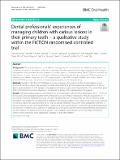Dental professionals’ experiences of managing children with carious lesions in their primary teeth – a qualitative study within the FiCTION randomised controlled trial
Abstract
Background The lack of evidence for the effective management of carious lesions in children’s primary teeth has caused uncertainty for the dental profession and patients. Possible approaches include conventional and biological management alongside best practice prevention, and best practice prevention alone. The FiCTION trial assessed the effectiveness of these options, and included a qualitative study exploring dental professionals’ (DPs) experiences of delivering the different treatment arms. This paper reports on how DPs managed children with carious lesions within FiCTION and how this related to their everyday experiences of doing dentistry. Methods Overall, 31 DPs from FiCTION-trained dental surgeries in four regions of the UK participated in semi-structured interviews about their experiences of the three treatment arms (conventional management of carious lesions and prevention (C + P), biological management of carious lesions and prevention (B + P) or prevention alone (PA)). A theoretical framework, drawing on social practice theory (SPT), was developed for analysis. Results Participants discussed perceived effectiveness of, and familiarity with, the three techniques. The C + P arm was familiar, but some participants questioned the effectiveness of conventional restorations. Attitudes towards the B + P arm varied in terms of familiarity, but once DPs were introduced to the techniques, this was seen as effective. While prevention was familiar, PA was described as ineffective. DPs manage children with carious lesions day-to-day, drawing on previous experience and knowledge of the child to provide what they view as the most appropriate treatment in the best interests of each child. Randomisation undermined these normal choices. Several DPs reported deviating from the trial arms in order to treat a patient in a particular way. Participants valued evidence-based dentistry, and expect to use the results of FiCTION to inform future practice. They anticipate continuing to use the full range of treatment options, and to personally select appropriate strategies for individual children. Conclusions RCTs take place in the context of day-to-day practices of doing dentistry. DPs employ experiential and interpersonal knowledge to act in the best interests of their patients. Randomisation within a clinical trial can present a source of tension for DPs, which has implications for assuring individual equipoise in future trials.
Citation
Marshman , Z , Kettle , J E , Holmes , R D , Cunningham , K B , Freeman , R , Gibson , B J , McColl , E , Maguire , A , Douglas , G V A , Clarkson , J E & Innes , N P T 2020 , ' Dental professionals’ experiences of managing children with carious lesions in their primary teeth – a qualitative study within the FiCTION randomised controlled trial ' , BMC Oral Health , vol. 20 , 64 . https://doi.org/10.1186/s12903-020-1051-7
Publication
BMC Oral Health
Status
Peer reviewed
ISSN
1472-6831Type
Journal article
Description
Funding: National Institute for Health Research Health Technology Assessment program (project number 07/44/03).Collections
Items in the St Andrews Research Repository are protected by copyright, with all rights reserved, unless otherwise indicated.

